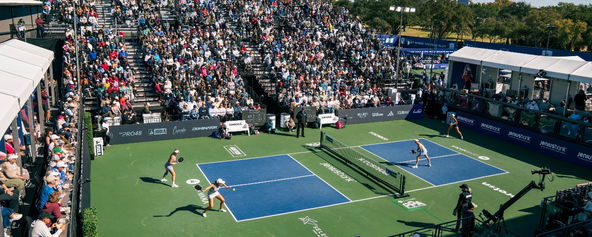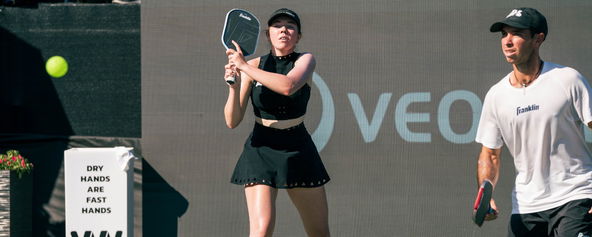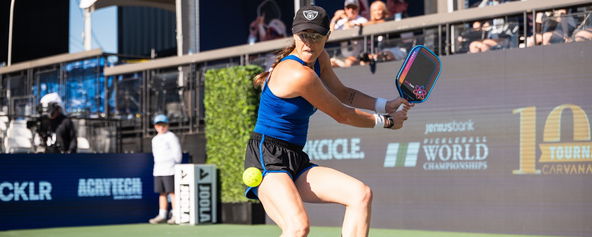
Explaining and exploring the breakup of Parenteau and Waters
Jim Kloss
Apr 08, 2025 07:30 AM ET
The big news this week in the pickleball world was the Instagram announcement by Catherine Parenteau that her longtime women’s doubles partnership with Anna Leigh Waters was ending. They most recently suffered a tough loss at the Veolia North Carolina Open to Jorja Johnson and Tyra Black. After attaining near unbeatable status in 2023, cracks in the armor began to show in 2024 with losses to Anna Bright and Rachel Rohrabacher. Parenteau/Waters remained the #1 team, but as the latest loss to Johnson/Black showed, no longer were they considered unbeatable. Yet they were still the undisputed No. 1 team, so why the split?
No matter what is said publicly, longtime successful pickleball partnerships split up for only three different reasons. First, there can be an injury or retirement. Second, there can be personal reasons, such as one player wants to cut back on how much they play, or they want to play left side so they have to switch to a partner who is a right side player. But, the third and most prevalent reason is that one player perceives their skill level as above that of their partner, such that their partner is holding them back. By far and away, the vast majority of pro pickleball partnerships split up for this third reason.
If we look at a couple of recent pro partnership splits, we see that the skill level difference is the cause of the splits. Ben Johns and Collin Johns had as much success as anyone, but still split because Ben was clearly a cut (or two) above Collin, and Collin was not adjusting to the faster game of 2025. Similarly, Federico Staksrud split from Pablo Tellez due to the belief that he would be more successful with other partners. Based on 2025 results, it does appear that both Ben and Federico made the right choices.
ADVERTISEMENT
Barring an announcement that Parenteau is retiring, the reason for the split with Waters is 100% because she sees herself as a cut above Parenteau, that Parenteau is dropping down the ladder in women’s doubles, and that Waters can do better with another partner. Is Waters right and is this the correct move?
Pro pickleball has changed over the last two years. The game is faster, there are more speedups and drives, and the ability to counter has become more important than the ability to reset. When attacked, players can respond by resetting, i.e., by trying to block the shot and return the ball softly to a hopefully non-attackable position. Or, the attacked player can try to counter, by aggressively counterattacking. It is the counterattack that generates exciting firefights, and when done successfully, a counter is what generates a finger wag at the opponent. Resets used to be the preferred shot, but as paddles have changed, the game has changed and now counters are preferred.
Parenteau’s situation is very similar, if not identical, to that of Collin Johns. Parenteau and Johns are both excellent right side players, who prefer resetting the ball to counterattacking. Both like to drop and dink, especially crosscourt, but both have tried to change their game some to adapt to the new conditions. Their styles dictate the correct strategy to use against them. For Collin playing with Ben, the correct strategy became to attack Collin relentlessly. Similarly, Bright and Rohrabacher showed that the correct strategy against Parenteau and Waters was to relentlessly attack Parenteau. This was the strategy employed by Johnson and Black in North Carolina to defeat Parenteau and Waters.
A closer look at the statistics from the Veolia North Carolina women’s doubles final is instructive. Johnson and Black attacked Parenteau much more often than Waters. For the match, Parenteau was the target of 22 speedups from Johnson/Black, while 12 were aimed at Waters (statistics courtesy of RealClearStats). Interestingly, Waters also did not play particularly well in the match. Both Parenteau and Waters averaged eight errors a game in the three games they lost (per RealClearStats).
We have now learned Waters is going to partner with Bright for the remainder of 2025. Why Anna Bright?
The factors Waters would consider for a partner are the same as Ben Johns went through when he picked Gabe Tardio. The factors are (1) age, (2) skill, (3) location, and (4) personality. Parenteau is 30. Pickleball, like tennis, is a young person’s game. Staying at the top after age 30 is not impossible, but it does become more difficult. For skill, Waters is not going to pick anyone outside the top 5. For location, Waters lives in Florida and is going to want a partner living in Florida so they can practice together. Finally, personality matters, as not every player gets along with every other player. It includes pickleball personality, as Waters will want a right side player, who can take the pressure of playing with the best player. We have seen how Tardio felt pressure when first playing with Johns, but now after a couple events, he has settled down and is more comfortable.
Anna Bright checks all the boxes. She is 25, lives in Florida, and can play well on either side. She has played top competition for a long time and is a leader of her MLP team, so she can handle the pressure. Most importantly, she brings to the partnership what Parenteau lacks: power and countering ability. This change is basically identical to Ben Johns switching from Collin Johns to Gabe Tardio. We see how well matched Tardio and Johns are, and I expect nothing different for Waters and Bright.
Follow me on X @pickleball_jim
Related articles

The greatest pickleball show on earth does it again in North Texas
History was made at Worlds with record-setting attendance, participation, and viewership, as well as a thrilling Triple Crown performance.
18 hours ago
-Matt Cudzinowski

PPA Tour’s final stop of 2025 is next week
A closer look at each draw for the Florida Dairy Farmers Daytona Beach Open.
19 hours ago
-Jim Kloss

Draws released for Florida Dairy Farmers Daytona Beach Open
Anna Leigh Waters isn't playing singles, so Kaitlyn Christian is the top seed.
1 day ago
-Pickleball.com Staff

Step aside, Spotify Wrapped: Anna Bright serves up hilarious 'Dating Wrapped'
Her comedic talent is undeniable.
1 day ago
-Victoria Radnothy





